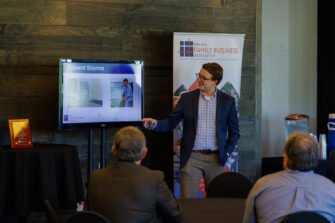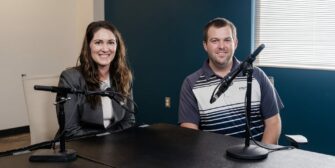Three Family Businesses Honored with Awards From Prairie Family Business Association
Recent News
Has your family business considered using EOS? This is the best way to start
Posted in PFBA | April 6, 2022
Shea Peffly was convinced to make a career change when she saw firsthand how effective the Entrepreneurial Operating System, or EOS, could be.
Developed by Gino Wickman and described in his bestselling book “Traction: Get a Grip on Your Business,” EOS tools are being used by more than 80,000 companies to improve the operational value of their business.
In 2016, Peffly was the CEO of a company that became one of them.
“I saw results,” she said. “I just loved the feeling I got seeing what the system will do for businesses.”
After using the system for more than two years, she was so sold on it she wanted to help other businesses achieve the same success.
Peffly now is a certified EOS implementer who is leveraging her own history of entrepreneurialism with her EOS expertise to guide businesses through their own journey to operational excellence.
She will speak as part of the 2022 Prairie Family Business Association annual conference April 28-29 in Sioux Falls. The event is sold out for in-person registration, but you still can register for virtual attendance.
Peffly’s appearance is part of a broader partnership between the Prairie Family Business Association and EOS Worldwide that began in 2020.
As part of the new strategic partnership, EOS provides Prairie Family Business Association members with access to EOS tools and dedicated support for businesses interested in finding Professional EOS Implementers. PFBA and EOS work together closely to deliver EOS training workshops, talks and books as part of PFBA’s education and outreach programs.
“Family-owned small businesses are the backbone of our economy.They provide 55 percent of all jobs in the U.S. and 54 percent of U.S. sales, according to the U.S. Small Business Administration,” said Pam Kosanke, an award-winning leader, marketer and implementer with EOS Worldwide.
“EOS Worldwide is thrilled to partner with the Prairie Family Business Association to help their entrepreneurial members be more successful and get more of what they want from their family businesses.”
A growing number of family businesses are finding success using the approach, and many others are considering it, said Stephanie Larscheid, executive director of the Prairie Family Business Association.
“Family businesses are finding EOS an incredibly valuable approach that is flexible enough to evolve with their changing circumstances,” Larscheid said. “No matter where you’re at in the EOS journey, you’re going to enjoy hearing an expert like Shea Peffly share her experience and what she’s discovered helping other businesses that likely will sound a lot like yours.”
For Peffly, the EOS journey began in her own Missouri-based veterans benefits company.
“Initially, it was painful,” she said. “We were a good company. There’s this perception that when your company isn’t doing well, you need EOS, but the majority of companies running on EOS are doing extremely well. They just want to do more, and that’s what the system will do.”
But as she worked through EOS, “there was so much that surfaced that we thought we were doing well,” she continued. “It’s that saying that you can’t see the forest for the trees. And the first pain point involved my senior executive leaders. In hindsight, they had gotten us to a certain point but were not the leaders to get us to the next point in the journey. Once the accountability started surfacing, I realized I no longer had the right people around the table.”
She made the difficult decisions, hired her team for the future and ultimately was able to put a succession plan in place that allowed her to exit.
“EOS is a simple operating system, but it is not easy,” she said. “It takes effort. It takes the commitment. It takes really owning that you have faith it’s going to make you better, and the process ultimately does that.”
She now sees multiple benefits helping other businesses run on EOS.
For family businesses
Peffly works with many family businesses, “and one of the things I see as being dysfunctional when I first start is that all the roles are intermingled,” she said. “Dad shows up, the president shows up, Mom shows up, the son shows up, all in the same business meeting.”
EOS establishes clear roles early on, including the threefold role many like: “a role as an owner, a role as working in the business and a role of mom, dad, son or whatever family role,” Peffly said. “So we have clarity of accountability. When we’re dealing with a business issue, mom and dad aren’t showing up.”
For businesses of many sizes
The sweet spot where EOS excels is businesses with 10 to 250 employees, Peffly said.
“That being said, if you’re just thinking about doing it, then act. Even if you’re not yet at 10 employees, there are tools you can begin implementing to create a solid foundation, so as you scale and hit that sweet spot, you’re so far ahead of others joining the journey.”
Her advice: Invite a certified implementer to a complimentary 90-minute meeting to talk about EOS.
“It will give you so much perspective around making an informed decision.”
For businesses with changing needs
For businesses struggling to manage all the demands of the moment, EOS provides focus, Peffly said.
“It’s tools that allow you to concentrate on the most important things in a 90-day world,” she said.
“Many people have a lot on their plate right now, they’re trying to play catch-up, and I’m reminding them you have a vision that needs to be executed by people. People are your bundle of energy, and EOS is an operating system that manages human energy and allows you to focus on your people. People will execute if they’re in a healthy and good culture, and I think we’ve lost sight of that.”
For businesses already in EOS
No matter where you’re at in the EOS process, pay attention to the foundational tools, Peffly said.
“Once you have mastered the tactical piece of EOS, the next level of mastery is understanding the art behind the science, and what EOS is actually doing for a business is the next-level ‘aha,’ and typically I see businesses don’t tap into that level unless they have an implementer with them on the journey,” she said.
“A lot of self-implementing companies hit the ceiling of status quo in about two years, and they’re doing great but not breaking through to the next level. Be careful when you feel that in your business because it means you’re ready for the next level.”
Click here to connect with the Prairie Family Business Association’s 2022 conference.




